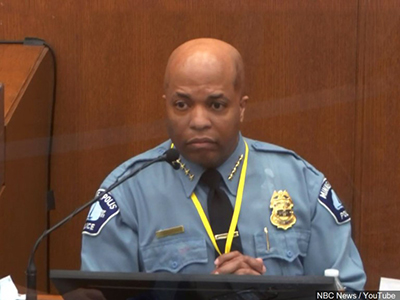
By MSR News Online
The second week of the Derek Chauvin murder trial kicked off with the much-anticipated testimony of Minneapolis Police Chief Medaria Arradondo who outright condemned former police officer Derek Chauvin in the killing of George Floyd. He said Chauvin’s use of force was in violation of Minneapolis Police Department (MPD) policy.
“Once there was no longer any resistance,” said Chief Arradondo, “and clearly when Mr. Floyd was no longer responsive and even motionless, to continue to apply that level of force to a person proned out, handcuffed behind their back—that in no way shape or form is anything that is by policy. It is not part of our training, and it is certainly not part of our ethics or our values.”
Arradondo, who became the first Black police chief of Minneapolis in 2017, spent the first of his more than two-hour testimony fielding questions from prosecutor Steve Schleicher about his 32-year history with the MPD. It was established through his testimony that he’s served in every rank within the department.
It wasn’t until after a break for lunch that Schleicher asked Arradondo about the events of May 25, 2020, when Chauvin pinned Floyd under his knee while he was handcuffed and in the prone position. Arradondo recalled that when he initially watched the city surveillance video of the fatal arrest, he didn’t see anything that alarmed him. The video was shot showing the back of the officers and from a distance.
It wasn’t until around midnight that a community member reached out to him to ask if he’d seen Darnella Frazier’s infamous video of Chauvin’s knee restraint on Floyd—force that should’ve stopped “once Mr. Floyd had stopped resisting, and certainly, once he was distressed and trying to verbalize that,” said Arradondo in court.
Arradondo fired all the officers involved in Floyd’s arrest within 24 hours of the incident. At the time he said, “The officers knew what was happening—one intentionally caused it and the others failed to prevent it. This was murder—it wasn’t a lack of training.”
In addition to his use of force, on the witness stand, Arradondo faulted Chauvin for not rendering aid to Floyd and not using de-escalation tactics during the arrest. In essence, the chief said that Chauvin showed little regard for Floyd’s sanctity of life, a concept that he stressed throughout his testimony as a pillar of the department.
“[Chauvin’s knee restraint] is not de-escalation. And when you talk about the framework of the sanctity of life…that action goes contrary to what we’re taught,” he said.
“We are oftentimes the first face of government that our community will see,” said Arradondo. “And we often meet them at their worst moments. It’s very important that for us to make sure we meet community in that space. Treating them with dignity; being their guardians.”
Similar to his cross-examination of Lt Richard Zimmerman on Friday, defense attorney Eric Nelson attempted to paint Arradondo as out-of-touch with everyday patrolling by asking him how long it’s been since he’s had to arrest someone. Arradondo admitted that it had been “quite some time.” Nelson also questioned the chief about department policy regarding restraints.
Before Arradondo took the stand, Dr. Bradford Langenfeld of the Hennepin County Medical Center, testified. He explained to the jury the life-savings measures that were attempted for 30 minutes before he pronounced Floyd dead. Ultimately, because of the lack of CPR and delay in care, Langenfeld said Floyd had little chance of recovering by the time he examined him.
He noted that he never received a report that Floyd had overdosed or had a heart attack, so he didn’t feel there was a specific toxin to reverse his condition. Instead, he said, based on the information he had at the time, he likely died of hypoxia or “asphyxia,” which is caused by an oxygen insufficiency. Upon cross-examination, Langenfeld acknowledged that fentanyl, a drug Floyd had in his system, can also cause asphyxia.
The Hennepin County’s Medical Examiner’s Office ruled Floyd’s death a homicide.
The day closed with Police Inspector Katie Blackwell, who led police training last year. She noted that the department teaches officers to use their arms when doing neck restraints. “I don’t know what type of improvised restraint that is,” said Blackwell of a photo of Chauvin’s knee restraint on Floyd. “That’s not what we train.”
She also testified that officers are trained about the dangers of “positional asphyxia,” which is caused by keeping a person in a position that can restrict their ability to breathe.
A total of six members of the MPD have testified against Chauvin so far, signaling a shift in officers’ willingness to cross the blue line against one of their own in a criminal trial. It also underscores the prosecution’s strategy to embrace law enforcement and frame their case as not one against the police, but against one rogue officer.
—Updated story to correct the date of death for George Floyd. We apologize for the error.


Be the first to comment